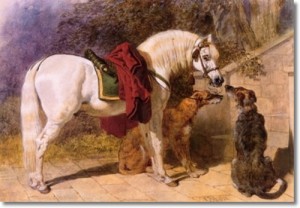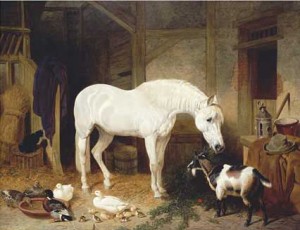Last week for art-day we looked at some of the history behind John Frederick Herring, Sr’s painting the ‘Pharaohs horses’. This week we focus on the man himself.
Herring ranks along with Sir Edwin Landseer as one of the more eminent animal painters of mid-nineteenth (19th) century Europe. As I mentioned last week Herring owned an Arabian horse Imaum whom he dearly loved and used as a model for some of his work. Imaun is all three heads in the ‘Pharaoh’s Horses’, as well as other horses in many of the Herring paintings.
John Frederick Herring, Sr.
Adapted from Wikipedia, the free encyclopaedia. www.wikipedia.org
John Frederick Herring, Sr. (1795 – 1865), was a painter, sign maker and coachman in Victorian England. John F. Herring, Sr. is the painter of the 1848 “Pharoah’s Chariot Horses” (archaic spelling “Pharoah”). He amended his signature “SR” (senior) in 1836, with the growing fame of his teenage son John Frederick Herring, Jr.
Herring, was born in London in 1795. He was of Dutch parentage and the son of a London merchant born overseas in America. Herring spent the first eighteen years of life in London, England, where his greatest passions were drawing and horses. He moved to Doncaster in the north of England, in 1814, at the age of 18, arriving in time to witness the Duke of Hamilton’s “William” win the St. Leger Stakes horserace. Herring married Ann Harris in 1815 his sons John Frederick Herring, Jr, Charles Herring, and Benjamin Herring were all artists, while his two daughters, Ann and Emma, both married painters. While in Doncaster, England, Herring was employed as a painter of inn signs and coach insignia for the sides of coaches, and his later contact with a firm owned by a Mr. Wood led to Herring’s subsequent employment as a night coach driver. His spare time was spent painting portraits of horses for inn parlours, and at the time he became known as the “artist coachman”. Herring’s talent was recognized by wealthy customers, and he began painting hunters and racehorses for the gentry.
After work
In 1830, John Frederick Herring, Senior left Doncaster for Newmarket, England, where he spent three years before moving to London, England. Herring experienced financial difficulties and was given financial assistance by W. T. Copeland, who commissioned many paintings. Some of these designs included some used for the Copeland Spode bone china. In 1840-1841, Herring visited Paris, painting several pictures, on the invitation of the Duc d’Orleans (the Duke of Orleans), son of the French King Louis-Phillipe.
In 1845, Herring was appointed Animal Painter to HRH the Duchess of Kent, followed by a subsequent commission from the ruling Queen Victoria, who remained a patron for the rest of his life.
In 1853, Herring moved to rural Kent in the southeast of England where he lived as a country squire. He then broadened his subject matter by painting agricultural scenes and narrative pictures, as well as his better known sporting works of hunting, racing and shooting.
His work was hugely popular, and many were engraved, including his 33 winners of the St. Leger and his 21 winners of the Derby. Herring exhibited at the Royal Academy from 1818-1865, at the British Institution from 1830-1865, and at the Society of British Artists in 1836-1852, where Herring became Vice-President in 1842.



4 Responses
Jake Gendy
I was very pleased to find this website.I wanted to thank for your time for this wonderful read!! I definitely enjoying every little bit of it and I have you bookmarked now to check out the new stuff you post to blog.
Patricia Barnes
I happened to own the Black and white Lithograph
Of Pharaohs Horses!
Orig. Wavey glass and Gesso Black Beaded Frame.
I only know it has been in my family for over a hundred
Years.
The Victorian Litho has been the Focal point
Of my Living Room above my Fireplace for
forty years.
It is so beautiful and much mystery behind
Who was the orig. Artist dating back to the
1300 Hundreds. My understanding is that my
Litho is approximately 1910.
Carmel Rowley
How sensational Patricia to own a lithograph of the Pharaohs Horses. Thanks so much for sharing this with us. Carmel
randall
i have an original JF Herring the three pharos it’s old and round canvas 24”